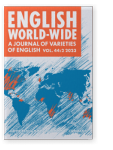Vol. 44:2 (2023) ► pp.276–302
Necessity modal development in Singapore English
An investigation of substratist and contact-grammaticalisation approaches
Spoken in a multilingual environment characterised by continuous contacts with other languages, Singapore English (SgE) is a singular object of study. Its modal system has also been developing in independent ways compared to inner-circle varieties, e.g. British English, its historical ancestor. Different approaches have attempted to explain such developments, including the substratist and the grammaticalisation approaches. The present paper explores both these approaches with the aim of examining the role that they may have in the development of the (semi-)modal verbs of necessity in SgE. Using some corpus analysis conducted on informal data, it will be shown why the substratist approach does not seem sufficient to explain the relatively frequent non-epistemic uses of must in SgE. It will be discussed how SgE must could be instead replicating older dynamic uses, typical of Middle English times (1100–1500 CE), according to a process known as replica grammaticalisation as recapitulation (Ziegeler 2014).
Article outline
- 1.Introduction
- 2.Background
- 3.Previous accounts on modality in CSE
- 3.1 Bao’s (2010) “convergence-to-substratum”
- 3.2Contact-grammaticalisation theories
- 4.Data, methods, and terminology
- 5.Results
- 5.1RQ1: Does the modal system of necessity in SgE replicate that of Mandarin Chinese?
- 5.2RQ2: Can Ziegeler’s (2014) theory explain the relatively frequent non-epistemic use of must in SgE today?
- 5.3RQ3: What is the role and use of the other necessity modals in SgE compared to BrE?
- 6.Discussion
- 7.Summary and conclusions
- Acknowledgements
- Notes
-
Sources -
References
